Search the Blog
Categories
- Books & Reading
- Broadband Buzz
- Census
- Education & Training
- Friday Reads
- General
- Grants
- Information Resources
- Library Management
- Nebraska Center for the Book
- Nebraska Libraries on the Web
- Nebraska Memories
- Now hiring @ your library
- Preservation
- Pretty Sweet Tech
- Programming
- Public Library Boards of Trustees
- Public Relations
- Talking Book & Braille Service (TBBS)
- Technology
- Uncategorized
- What's Up Doc / Govdocs
- Youth Services
Archives
Subscribe
Tag Archives: Friday Reads
Friday Reads: “New Prairie Kitchen” by Summer Miller. Photographs by Dana Damewood.
 It seems like the best cookbooks are the ones that tell a story—in addition to sharing great recipes and scrumptious photos. Recently I’ve been reading the stories, trying the recipes, and gazing at the photos in New Prairie Kitchen by Summer Miller. The author, a young mom and freelance writer from the Omaha area, explored restaurants and farms within a 200-mile radius of Omaha and brings us stories of real people who grow, prepare, and serve real food for their families and friends. The author says that the book “…pays homage to the outstanding and innovative chefs, farmers, and artisans of Nebraska, Iowa, and South Dakota. They have shared some of their favorite recipes here, organized by season and focused on regionally sourced meat, poultry, game, and produce. Profiles of these exceptional people are nestled throughout the book.” I love the stories and photos, and I’m loving the food, as well.
It seems like the best cookbooks are the ones that tell a story—in addition to sharing great recipes and scrumptious photos. Recently I’ve been reading the stories, trying the recipes, and gazing at the photos in New Prairie Kitchen by Summer Miller. The author, a young mom and freelance writer from the Omaha area, explored restaurants and farms within a 200-mile radius of Omaha and brings us stories of real people who grow, prepare, and serve real food for their families and friends. The author says that the book “…pays homage to the outstanding and innovative chefs, farmers, and artisans of Nebraska, Iowa, and South Dakota. They have shared some of their favorite recipes here, organized by season and focused on regionally sourced meat, poultry, game, and produce. Profiles of these exceptional people are nestled throughout the book.” I love the stories and photos, and I’m loving the food, as well.
After perusing the New Prairie Kitchen recipes, I went to the Farmer’s Market and bought a 4 pound pork shoulder roast from a local producer that was perfect for trying the Spice-Rubbed Slow-Cooker Pork (Kevin Shinn of Bread and Cup in Lincoln, NE). What could be simpler than a spice rub and a slow cooker? I did have to add some liquid to mine since my slow-cooker must be a little on the hot side, but after 6 hours the roast was juicy and fragrant—and I shredded it apart with two forks just like the experts on the cooking channel on TV. I should have made a YouTube video. Next, my backyard bumper crop of heirloom tomatoes inspired me to make Tomato Chutney (Sean Wilson of Proof in Des Moines, IA) and Tomato Marmalade (Clayton Chapman of The Grey Plume in Omaha, NE). Both are delicious on bread and cheese—and as a bonus, I got to use some of the garlic and jalapeño chilies from my garden too. And I’m not done yet. I’ll be making the Black Walnut and Clove Muffins (Maggie Pleskac of Maggie’s Vegetarian Café in Lincoln, NE) for the next Nebraska Library Commission potluck—and more.
The book might also provide a little tourism boost. The food sounds so good, it makes me want to hop in the car and go out in search of the places where other people will make this yummy food for me. Maybe a trip to the Back Alley Bakery in Hastings, NE is in my future?
To find out more about this Nebraska Book Award-winning cookbook and the “foodways” of the Great Plains, see Summer Miller’s blog at http://www.scaldedmilk.com/.
Review by Mary Jo Ryan.
#fridayreads
Friday Reads: Confessions of a Domestic Failure by Bunmi Laditan
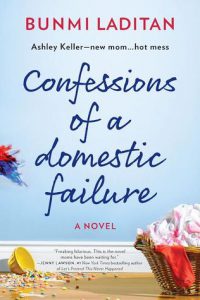 While my summer reading list was often full of nonfiction, despairing memoirs, and dystopian nightmare scenarios, sometimes I just need to escape into a quick summer beach read. In this case, my interlude came in the form of “mommy lit” – stories about mothers of young kids; sleep-deprived mothers who are running on coffee and dinosaur-shaped chicken nuggets; moms who love their little ones dearly, but occasionally fantasize about long-ago child-free spa weekends – you know, someone I can relate to.
While my summer reading list was often full of nonfiction, despairing memoirs, and dystopian nightmare scenarios, sometimes I just need to escape into a quick summer beach read. In this case, my interlude came in the form of “mommy lit” – stories about mothers of young kids; sleep-deprived mothers who are running on coffee and dinosaur-shaped chicken nuggets; moms who love their little ones dearly, but occasionally fantasize about long-ago child-free spa weekends – you know, someone I can relate to.
If you aren’t familiar with Bumni Laditan, she’s the creator of The Honest Toddler, a blog-turned-book written in that voice we all secretly think belongs to our own children. Confessions of a Domestic Failure is Laditan’s first novel, and it centers around Ashley Keller, a newly minted stay-at-home-mom (by way of corporate layoff).
Ashley is smart and resourceful – she was an ace at her marketing job before the layoff, and she can fashion an emergency diaper out of items in the backseat of her car – but she is also failing spectacularly at creating the blissful family life she thinks is expected of her. Her house is a mess, she hasn’t lost the baby weight, her daughter rarely makes it out of pajamas (so much for all those cute baby clothes!), and she is struggling to be supportive of her husband’s decision to quit his own corporate job to start a new company.
Ashley is determined to be a Pinterest-perfect mother with an Instagram-worthy home and a huge circle of supportive mommy gal pals… if she can ever peel off her Cheerio-crusted yoga pants and find the energy to shower. Laditan perfectly and hilariously captures the isolation and exhaustion of new motherhood and the pressures social media creates to project perfection.
Ashley is offered a chance to compete in a “Motherhood Better” competition held by superstar mommy-blogger Emily Walker. She stumbles through each challenge, and madcap antics ensue – from accidentally mooning the other competitors during a live video conference, to lying her way into a breastfeeding support group (though her daughter takes formula) while trying to make mom-friends, to nearly setting her house ablaze while “crafting”. But somehow she makes it to the finals and gets to meet her idol Emily. Will she win the contest and push her jogging stroller into the sunset… or will the pressure of domestic perfection cause her to crash and burn?
Friday Reads: Restart by Gordon Korman
Chase (8th grade) wakes up in the hospital and remembers nothing of 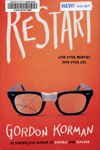 who he is, or his family—the group of people standing around his bed looking at him. He remembers how to walk, talk, eat, read, all the daily things we all do, but nothing personal about himself. His school is unfamiliar, but as he walks down the hall he notices students cringing away from him. Slowly he begins to discover that he has been the reigning bully, and not only that, he has encouraged his former two best friends to do it too. As the 8th grade team quarterback, he ruled the school. But now he is repulsed by who he was. How did he get that way when now his impulses are to be friendly and helpful? And what should he do now?
who he is, or his family—the group of people standing around his bed looking at him. He remembers how to walk, talk, eat, read, all the daily things we all do, but nothing personal about himself. His school is unfamiliar, but as he walks down the hall he notices students cringing away from him. Slowly he begins to discover that he has been the reigning bully, and not only that, he has encouraged his former two best friends to do it too. As the 8th grade team quarterback, he ruled the school. But now he is repulsed by who he was. How did he get that way when now his impulses are to be friendly and helpful? And what should he do now?
This is a fascinating look at human behavior, our inner selves vs. our outer selves, and how we may end up so far from where we were meant to go. The author is known for his humorous books, but this one takes a more serious, and intriguing path.
Friday Reads: Finders-Seekers
 I’ve always been a scifi/fantasy fan, and The Ghatti’s Tale: Book One: Finders-Seekers, by Gayle Greeno, has a little of both. Mostly fantasy at the time of the story, but scifi in the past.
I’ve always been a scifi/fantasy fan, and The Ghatti’s Tale: Book One: Finders-Seekers, by Gayle Greeno, has a little of both. Mostly fantasy at the time of the story, but scifi in the past.
Over 200 years ago, colonists from earth came to the planet Methuen. Most of their technology has been mysteriously destroyed over the years. During their time on the planet they have developed a new ability – telepathic bonding with the native ghatti.
The ghatti are race of large cats on Methuen who can speak telepathically to humans, if they choose to bond with them. I wish I could talk to my cats, in any way at all. Would make my life so much easier!
These human-ghatti Bondmates settle disputes using their shared ability to truth-read people’s minds and emotions. However, not everyone may appreciate this involvement in their affairs. In The Ghatti’s Tale, telepathic humans and ghatti are being murdered. One pair of Bondmates, a woman Doyce, and her ghatta Khar’pern, have been chosen to find out who is doing this and why. Doyce has a special interest in the murders, as her intended fiance has become one of the victims.
I was thoroughly engrossed in this story and the characters. This is the first book in the three book Ghatti’s Tale series. Book 2 is MindSpeakers’ Call and Book 3 is Exiles’ Return. And there is a followup 2 books series that continues the story – Ghattens Gambit, made up of Sunderlies Seeking and The Farthest Seeking. So, if you’re like me, and after the first book you have to know what happens next, there’s plenty more to read!
Friday Reads: Bohemians: A Graphic History by Paul Buhle and David Berger
Bohemians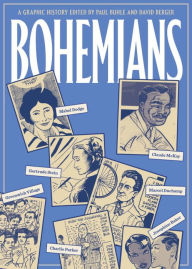 is an enjoyable, and flawed, collection of illustrated vignettes about influential people, places and times in the bohemian movement. Beginning in 1850s Paris, and ending in 1950s New York, several different graphic artists take a turn at telling part of the bohemian story. The variety of artistic styles keeps the eye interested, and many of the characters you already know are larger than life—Walt Whitman, Josephine Baker, Marcel Duchamp, Gertrude Stein, and Charlie Parker.
is an enjoyable, and flawed, collection of illustrated vignettes about influential people, places and times in the bohemian movement. Beginning in 1850s Paris, and ending in 1950s New York, several different graphic artists take a turn at telling part of the bohemian story. The variety of artistic styles keeps the eye interested, and many of the characters you already know are larger than life—Walt Whitman, Josephine Baker, Marcel Duchamp, Gertrude Stein, and Charlie Parker.
So what is a bohemian? The authors will give you many possible examples, but they will not give you an exact definition, which is appropriate considering that the movement itself encouraged disregarding boundaries and not letting life be limited by societal expectations. You could argue that free love and free thought were important to bohemians, but you’d want to remember those words meant something different in the Victorian era (and even in the United States of the 1950s), when rigid conformity was expected in society and relationships, even more so than today.
I read one review of this book by Joseph Donica in Journal of Graphic Novels and Comics that had this great line: “One rarely reads a book that disappoints on several levels and still decides to recommend that book to every likeminded reader he knows.” I think I like the book more than this reviewer, but I have reservations. I think advances in technology had a lot to do with the appeal of this movement—entertainment and communication were changing, and their influence on society can’t be underestimated. (This beginning of this era brings us the invention or accepted use of the telephone, the phonograph, the typewriter, and the camera.) Also, and this might be a critique more of the movement than the book—it’s easier for some people to reject society’s rules and still have a comfortable life, than it is for others. Class, race, and gender power structures still existed in the world, and sometimes the authors don’t give us this historical context—some bohemians sought freedom from, and some sought freedom to. But the stories are definitely enjoyable, and there’s enough of a variety that you’ll find plenty to appreciate even if not every story is to your liking. The graphic novel format works effectively in its portrayal of an array of places and times.
The authors prefer not to capitalize bohemian—perhaps to clearly separate the bohemian culture from the geographic area of Bohemia, which as Nebraskans (familiar with the “Bohemian Alps”) we know is a region of the Czech Republic. Incorrectly thought by nineteenth-century French dilettante historians to be the place of origin of the Romani people (sometimes known as “gypsy” people, a term now recognized as pejorative), the movement took the name because it found the Romani people’s “freedom” to be inspiring. This might seem strange to the modern reader, who knows that the Romani people were persecuted and impoverished, and later almost wiped out completely by the Third Reich. To think of their lives as “romantic” and “free” seems optimistic at best.
Buhle, Paul, and David Berger. Bohemians: A Graphic History, 2014. Print.
Friday Reads: You Gotta BE the Book by Jeffrey Wilhelm
 “…engaged reading — beyond involving cognitive processes (as the Core and next-generation standards emphasize) — is a deeply emotional, participatory, dramatic, embodied, visual, artistic, psychological, and potentially transformational pursuit. This we must not forget as teachers or as readers, or we will not tap into the immense power of reading, and thus we limit our capacity to be effective teachers or readers.”
“…engaged reading — beyond involving cognitive processes (as the Core and next-generation standards emphasize) — is a deeply emotional, participatory, dramatic, embodied, visual, artistic, psychological, and potentially transformational pursuit. This we must not forget as teachers or as readers, or we will not tap into the immense power of reading, and thus we limit our capacity to be effective teachers or readers.”
Why do some students struggle with reading? Why can’t they “see” the story in their mind or connect with text? What are highly engaged readers doing or thinking when they read? How is this different from struggling readers and how can they be helped?
While this book isn’t exactly an exciting summer beach read, it’s always interesting to read about reading, I think. First published in 1996, with a third edition published in 2016, You Gotta BE the Book examines Jeffrey Wilhelm’s research in his middle school classrooms teaching his own experiences and through student stories from both engaged and struggling readers.
Wilhelm describes his difficulties trying to teach students who continually insist that they hate reading. They don’t enjoy reading and it’s difficult for them. Working with individual readers at all levels allowed Wilhelm to develop different interventions/strategies which then helped his students practice visualizing the text, creating the opportunities necessary for struggling readers to finally connect with literature in meaningful ways. The book is an interesting mix between Wilhelm’s early reflections as a teacher, the feedback of his students, and reading theory. The visualization strategies and activity ideas, including drama and art, that Wilhelm describes could also be adapted outside of the classroom.
“You Gotta BE the Book”: Teaching Engaged and Reflective Reading with Adolescents, Third Edition by Jeffrey Wilhelm (2016)
Also, if you want to read more about literacy theories, this is a good introduction:
Lenses on Reading: An Introduction to Theories and Models by Diane Tracey and Lesley Morrow (2012)
And another related book to add to your list, just because it’s interesting:
Reading Don’t Fix No Chevys: Literacy in the Lives of Young Men by Michael Smith and Jeffrey Wilhelm (2002)
Friday Reads: Norse Mythology by Neil Gaiman
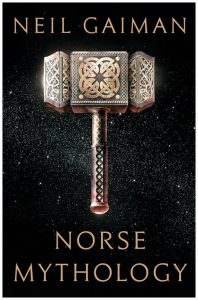
Norse Mythology
I’ve always loved mythology. I’ve read Greek, Roman, Norse, Egyptian, and middle eastern. But one of the books I loved, long ago, was of Norse mythology.
And as usual, Neil Gaiman delivers. The gods here are more equally represented, although Thor and Loki do manage to take up a lot of space in the stories. But these aren’t the gods as presented by Kirby and Stan Lee, and dialogued by Stan Lee’s brother Larry Lieber. These are the true Norse gods, terrible, dangerous, ancient, and to be called on only at your peril. Loki is not conflicted, but definitely without remorse. Thor, well, red bearded and not so bright. Odin is a dark, brooding wise and terrible. Even the goddesses are not entirely one sided.
The forward is worth reading for the origins of these particular stories. The author points out the melding of religions in the battles of the gods of the Vanir (brother & sister nature gods) and the Aesir (who we usually think of as the Norse gods.) There is included a story about the battle, and how they made peace. He mentions all the lost stories about goddesses, that he’d have liked to have included. The sources he used and didn’t use.
And then there are the progression of the stories. He begins, with a creation story, of fire and ice, and of course ends with the end story of Ragnarök, which is also a beginning. All the stories are set in a mythical, setting, Midgard is Earth, where the humans (mortals) dwell, and Asgard where the Aesir dwell, a world where the light elves dwell, a world where the dwarves dwell, and one where the ice giants dwell. There are nine worlds. And no one seems to be able to stay in their own world. Which of course, causes many of the problems in the stories. The stories do run in a progression, from creation to a sort of ending of an old world. They can be read as short stories, or read as a longer narrative. One does lead into the next. Neil Gaiman called the stories a journey. And so they are, a journey to a culture long gone.
Friday Reads: The Comedians: Drunks, Thieves, Scoundrels and the History of American Comedy by Kliph Nesteroff
I’ve had bad book luck lately. Even titles that have won fancy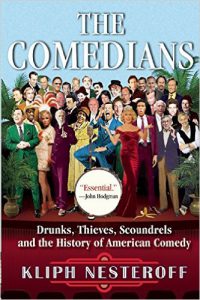 awards have left me feeling pretty unsatisfied. But The Comedians broke my streak—this is a fantastic book, strong enough to be considered the definitive work on the subject. Nesteroff starts off with comedy’s beginnings in Vaudeville and progresses through the radio era, comedy clubs and cable specials, & sketch comedy and variety shows. The title is not a rib—this is a serious, expansive history of comedy as an art form and business—and the treatment of the material might disappoint people who just want a laugh-a-minute romp. But they’ll be missing out if they skip this book.
awards have left me feeling pretty unsatisfied. But The Comedians broke my streak—this is a fantastic book, strong enough to be considered the definitive work on the subject. Nesteroff starts off with comedy’s beginnings in Vaudeville and progresses through the radio era, comedy clubs and cable specials, & sketch comedy and variety shows. The title is not a rib—this is a serious, expansive history of comedy as an art form and business—and the treatment of the material might disappoint people who just want a laugh-a-minute romp. But they’ll be missing out if they skip this book.
The title is also not kidding about the “drunks, thieves, scoundrels” part. Early American comedy had strong links to seedy elements and there are numerous examples of that here—insult comics getting threatened by the Mafiosi sitting in the audience, people dying when cheap comedy clubs collapsed. Beyond its chronicles of actual violence, The Comedians also devotes a fair bit of time to the “crying clown” idea and prevalence of addiction in comedy. Some famous names come across as very broken people and a few emerge as basically forever-unhappy monsters. Some of your favorites might seem a little tarnished after you read it and The Comedians occasionally gets gossipy in a Hollywood Babylon kind of way. But, most of the time, it takes the high road and tells the story of the art form in a fun and engaging fashion. It does for comedy what David J. Skal’s epic The Monster Show did for the history of horror.
One of the most important things about the book is its championing of obscure comedians. Everybody knows the Marx Brothers and Joan Rivers, but it was great to learn about people like Eddie Cantor and Fred Allen, especially at a time when radio-era comedy is instantly accessible through sources like the Internet Archive. If a comedian is/was important, they’re almost certainly here. As I neared the end of the book, I was getting nervous that Andy Kaufman hadn’t been mentioned yet, but The Comedians came through for me. Because of the book’s massive scope, nobody gets tons of spotlight time, but you’ll finish this with a solid understanding of pretty much everything you’d ever want to know about American comedy.
Nesteroff, K. (2015). The Comedians Drunks, Thieves, Scoundrels, and the History of American Comedy. Pgw.
Friday Reads: Burn for Me by Ilona Andrews
Hel lo to all the loyal Friday Reads review readers! I am aware that it is Monday, but apparently computers have proven to be my downfall once again. While I had a Reads scheduled to go out, it decided not to budge. Luckily, any day is a good day for reading, so Happy Monday Reads!
lo to all the loyal Friday Reads review readers! I am aware that it is Monday, but apparently computers have proven to be my downfall once again. While I had a Reads scheduled to go out, it decided not to budge. Luckily, any day is a good day for reading, so Happy Monday Reads!
On to the review:
This review is for a book called Burn for Me by Ilona Andrews. I chose this book because I loved the series but the book cover barely represented the content of the book. If you will notice, the cover makes it look like a bodice ripper. It is not. There are some delightfully steamy moments (I have no shame), but the couple is fighting their feelings through most of the book. Throughout the whole book, they do not cling to each other with wanton longing like they do on the front cover.
Now let’s dive deeper into the book:
This is the first in a book series that was written by a married couple who go by the pseudonym Ilona Andrews. They are a fascinating couple, but that is a tangent for another day. Nevada Baylor and Connor Rogan are the couple (supposedly) featured on the cover of this book. The series is told from the perspective of Nevada who is a private investigator who runs the firm with her delightfully quirky family. Rogan is an irresistibly sexy multibillionaire with magical powers who
No, wait, come back! Okay, stay with me now here. He’s different from all the other irresistibly sexy multibillionaires. This series is set in a world where a serum was developed in the 1800s which allows people to develop magical powers. People can do anything from starting fires, to mind-control, to controlling the elements. It is awesome. The world dynamics shifted so that people with greater magical abilities have more political power than those who do not. Rogan is a Prime and Primes have the highest level of power. People fear Rogan, but women still want him to rip their bodices from their dainty shoulders.
Nevada is not dainty. She will punch you in the face if you try to rip off her bodice. And maybe do creative things to your nether regions. Hmm…that didn’t come out the way I intended. Did I mention the cover is not representative of the book?
In any case, the Andrews duo does some great world building and writes some delicious banter. Oh, the banter! I need a moment…
Okay, I’m back. I will leave you with these thoughts: I’m a librarian. I read everything. I was not afraid to pick up a book that looked like a paranormal bodice ripper. I have a soft spot for sexy werewolves. But this is more of an urban fantasy. There are no werewolves, vampires, witches, or anything like that. There are just regular, normal people who occasionally summon the power to chuck cars across the street.
If you like sarcastic and witty female protagonists and do not want a lot of sappy romance, this is the book for you. If you actually were looking for a book to match the cover on here, have I got some books for you…
Andrews, Illona. Burn for Me. Avon: New York, NY, 2015.
Friday Reads: The Women in the Castle
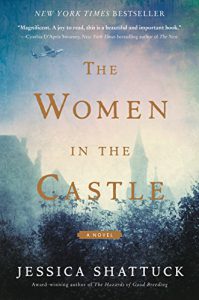 My favorite genre to read is historical fiction. I really enjoy learning something about history at the same time that I’m enjoying fiction. And occasionally, from within that genre, there comes along a book that makes the reader reconsider what they know about a certain period or event in history. The Women in the Castle, by Jessica Shattuck, is an excellent example. For all that we know and have heard about World War II and the Holocaust in Germany, there is much we haven’t heard about how the rest of the German population survived during and after the war. The Women in the Castle tells us part of that story:
My favorite genre to read is historical fiction. I really enjoy learning something about history at the same time that I’m enjoying fiction. And occasionally, from within that genre, there comes along a book that makes the reader reconsider what they know about a certain period or event in history. The Women in the Castle, by Jessica Shattuck, is an excellent example. For all that we know and have heard about World War II and the Holocaust in Germany, there is much we haven’t heard about how the rest of the German population survived during and after the war. The Women in the Castle tells us part of that story:
After Nazi Germany’s defeat, Marianne von Lingenfels returns as a widow to the castle of her husband’s ancestors, now fallen into ruin after long years of war. Along the way, she follows through on a promise she made to her husband and others of the resistance: to find and protect their wives, also widows like herself.
Marianne first rescues six-year-old Martin, the son of a resister, from a Nazi reeducation home. Together they make their way across war-torn Germany to Berlin, where they rescue Martin’s mother, Benita, from life as a prostitute to the Red Army. Then Marianne locates Ania, another resister’s wife, and her two boys, now refugees in one of the many displacement camps around the country.
As Marianne tries to create a family from the survivors of her husband’s resistance movement, she is certain their shared pain and circumstances will hold them together. But she quickly discovers that their previous lives, plus events that continue to bombard them as the country recovers, have complicated their perceptions with dark secrets that threaten to tear them apart. Eventually all three women must come to terms with the choices that they made before, during, and after the war – each with her own unique set of challenges.
If you enjoyed reading The Nightingale, Sarah’s Key, or The Light Between Oceans, you will definitely enjoy The Women in the Castle, by Jessica Shattuck.
Posted in Books & Reading, General, Information Resources, Programming, Uncategorized
Tagged Friday Reads
Leave a comment
Friday Reads: “Hero of the Empire: The Boer War, a Daring Escape, and the Making of Winston Churchill” by Candice Millard
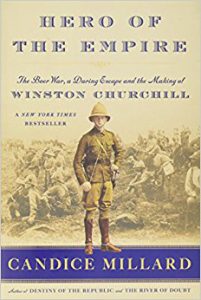 Candice Millard, author of River of Doubt (2005) and Destiny of the Republic (2011), is one of my favorite nonfiction authors. Her latest book, Hero of the Empire, is about Winston Churchill and, like many previous biographies of the famous Prime Minister, it focuses on a specific period in his life—his participation in the Boer War (1899–1902) instead of on its entirety. Examples of other focused explorations include last year’s Masterpiece Theater premier, Churchill’s Secret. This drama is set during Churchill’s second term as Prime Minister, when the 78-year-old leader (played by Michael Gambon) struggled, with the help of his wife, to conceal a debilitating stroke and an incapacity to govern. The popular Netflix miniseries The Crown cast 6’4” actor John Lithgow for its version of 5’6” Churchill during the early reign of Queen Elizabeth, revealing the private relationship between a PM and a young Sovereign. Yet another biography is a 2010 documentary entitled Walking with Destiny, in which historian John Lukacs explains that “Churchill may not have won the War in 1940, but without him, the War most certainly would have been lost.”
Candice Millard, author of River of Doubt (2005) and Destiny of the Republic (2011), is one of my favorite nonfiction authors. Her latest book, Hero of the Empire, is about Winston Churchill and, like many previous biographies of the famous Prime Minister, it focuses on a specific period in his life—his participation in the Boer War (1899–1902) instead of on its entirety. Examples of other focused explorations include last year’s Masterpiece Theater premier, Churchill’s Secret. This drama is set during Churchill’s second term as Prime Minister, when the 78-year-old leader (played by Michael Gambon) struggled, with the help of his wife, to conceal a debilitating stroke and an incapacity to govern. The popular Netflix miniseries The Crown cast 6’4” actor John Lithgow for its version of 5’6” Churchill during the early reign of Queen Elizabeth, revealing the private relationship between a PM and a young Sovereign. Yet another biography is a 2010 documentary entitled Walking with Destiny, in which historian John Lukacs explains that “Churchill may not have won the War in 1940, but without him, the War most certainly would have been lost.”
In Hero of the Empire: The Boer War, a Daring Escape, and the Making of Winston Churchill, Millard describes the bravado of a young man who both wants and needs to go to war in hopes of gaining medals and fame as capital for his future political career. Churchill agrees to be a war correspondent in South Africa’s Boer War, where the British were both overconfident and under prepared. When the train Churchill is traveling on is ambushed and derailed by Boer troops, Churchill calmly rallied British troops under enemy fire to clear the track and let the engine get away with the wounded. Most of the remaining British, along with Churchill, were captured. This was the first time in his young life he was not in control of his own destiny. It is his spectacular escape, with the help of several kind strangers along the way that helps him to become a hero who rejoins the British troops both as an officer and a war correspondent. In a 2003 PBS Documentary entitled Churchill, this entire story is recounted in one sentence.
With my interest in Churchill piqued by Millard’s book, and inspired to learn more, I ran across this intriguing quote from Pamela Plowden, the woman he was in love with before he married his beloved wife Clementine and with whom he maintained a lifelong friendship. She described Winston this way: “When you first meet Winston, you see all his faults. You spend the rest of your life discovering his virtues.” This is where I find myself in the last pages of Millard’s text – having been introduced to a multitude of his shortcomings but also seeing glimmers of his many redemptive qualities. Certainly his charisma and masterful public speaking skills are shown throughout his life and his place in history is one to be both reckoned and respected.
What makes Millard one of my favorite authors is her ability to create a cinematic and fascinating description of events that ordinarily might not compel me and dialog that is on par with some of my favorite screen writers. One of her Amazon reviewers pleads for this text to be turned into a movie. As Hollywood frequently adapts books for cinematic creations, I would imagine Millard’s titles will most certainly be adapted and yet another actor will be cast to play this iconic man of history.
Millard, Candice. Hero of the Empire: The Boer War, a Daring Escape, and the Making of Winston Churchill. New York: Doubleday, 2016
Friday Reads: The Handmaid’s Tale
 Many of the books I read are populated by strong female characters. Biography, science fiction, literature, mystery – all feature intelligent, feisty and powerful women. Margaret Atwood’s The Handmaid’s Tale is no exception.
Many of the books I read are populated by strong female characters. Biography, science fiction, literature, mystery – all feature intelligent, feisty and powerful women. Margaret Atwood’s The Handmaid’s Tale is no exception.
Set at an unknown point in time, The Handmaid’s Tale is the story of a woman named Offred. The story alternates between Offred’s current day-to-day existence and her memories of a past life. One with a daughter, a loving husband, and a fulfilling career. Now, Offred is valued more for her functioning ovaries than her intelligence.
Offred’s life shifted drastically because the United States no longer exists. In response to declining birth rates and civil unrest, a group of fundamental Christian militants overthrow the government. The Republic of Gilead, as this country is known, institutes a rigid social hierarchy and enacts laws inspired by the Old Testament. Young and healthy women, like Offred, are classified as handmaids and assigned to the homes of childless high-ranking government officials and their wives. Their job is to bear these men’s children.
Although the Republic of Gilead has stripped Offred of her rights, she refuses to give up. She finds ways to assert her independence by swinging her hips while walking or through unsanctioned interactions with men. Often, Offred risks her limited freedom by looking for people who may be able to help her escape from Gilead. Offred reminds us that rebellion doesn’t have to be loud. It can be quiet and slow-burning and still succeed in the end.
The Handmaid’s Tale is currently airing as a series on Hulu.
Atwood, Margaret. The Handmaid’s Tale. New York: Anchor Books, 1986.
Friday Reads: The Fire Next Time, by James Baldwin
 After watching I Am Not Your Negro, the Oscar-nominated documentary based on an unfinished James Baldwin manuscript, I finally tracked down and read Baldwin’s much-referenced 1963 book, The Fire Next Time. This book contains two essays: “My Dungeon Shook—Letter to my Nephew on the One Hundredth Anniversary of Emancipation,” and “Down At The Cross—Letter from a Region of My Mind.”
After watching I Am Not Your Negro, the Oscar-nominated documentary based on an unfinished James Baldwin manuscript, I finally tracked down and read Baldwin’s much-referenced 1963 book, The Fire Next Time. This book contains two essays: “My Dungeon Shook—Letter to my Nephew on the One Hundredth Anniversary of Emancipation,” and “Down At The Cross—Letter from a Region of My Mind.”
In the first essay, Baldwin endeavors to impart to his 15-year-old nephew the wisdom and advice he’ll need to survive growing up as a black man in America. Despite being “born into a society which spelled out with brutal clarity and in as many ways as possible that you were a worthless human being,” Baldwin urges his nephew to trust his own experience, to resist internalizing messages of inferiority, and to continue to love. And in a more sophisticated exhortation than our contemporary “Make America Great Again” slogan, Baldwin writes: “Great men have done great things here and will again and we can make America what America must become.” This essay actually served as inspiration for Ta-Nehisi Coates’s 2015 book, Between the World and Me, which took the form of a letter to his own teenage son. The tragedy, of course, is that such letters are still necessary.
The second essay, “Down At The Cross—Letter from a Region of My Mind,” is quite a bit longer than the first. In it Baldwin recounts his experiences with the Christian church during his youth and the Nation of Islam as an adult, seeing in neither a solution to the racial problems that infect America. Throughout, he offers an unsparing analysis of the problematic role race has played in the development of American civilization, “which compromises, when it does not corrupt, all the American efforts to build a better world…”
This essay is a demoralizing read because of how applicable Baldwin’s criticisms remain. “People are not, for example,” Baldwin writes, “terribly anxious to be equal (equal, after all to what and to whom?) but they love the idea of being superior.” And also: “It is rare indeed that people give. Most people guard and keep; they suppose that it is they themselves and what they identify with themselves that they are guarding and keeping, whereas what they are actually guarding and keeping is their system of reality and what they assume themselves to be.”
Baldwin’s writing is not without hope, but his is a bleak optimism–more philosophical choice than true faith. This perspective is powerfully captured in a 1963 television interview (“The Negro and The American Promise,” WGBH), in his response to a question about whether he is a pessimist or optimist: “I can’t be a pessimist because I’m alive. To be a pessimist means that you have agreed that human life is an academic matter, so I’m forced to be an optimist. I’m forced to believe that we can survive whatever we must survive.” As he did in his letter to his nephew, in this essay he holds out love as the only way forward. But he makes clear that when he uses the word “love” he is referring to “a state of being, or a state of grace—not in the infantile American sense of being made happy but in the tough and universal sense of quest and daring and growth.”
Baldwin, James. The Fire Next Time. Ashland, Oregon: Blackstone Audio, 2008.
Friday Reads: “The Dinner” by Herman Koch
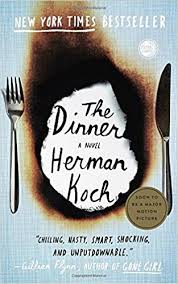 The Dinner, published in 2009, involves the relationships among two brothers, their wives, and teenage children. The story centers on a dinner at an upscale Amsterdam restaurant. This dark and disturbing book unfolds steadily with unpredictable twists, pivots, and surprises. Paul Lohman, the narrator and one of the two brothers, offers caustic observations throughout the dinner. Here’s a sample:
The Dinner, published in 2009, involves the relationships among two brothers, their wives, and teenage children. The story centers on a dinner at an upscale Amsterdam restaurant. This dark and disturbing book unfolds steadily with unpredictable twists, pivots, and surprises. Paul Lohman, the narrator and one of the two brothers, offers caustic observations throughout the dinner. Here’s a sample:
“So when the bartender at the café put our beers down in front of us, Claire and I smiled at each other in the knowledge that we would soon be spending an entire evening in the company of the Lohmans – in the knowledge that this was the finest moment of that evening, that from here on it would all be downhill.”
The meal and conversation are frequented with disruptions and flashbacks. It is eventually realized that the purpose of the dinner is to discuss the two couples’ teenage boys and their involvement in a brutal and criminal act. The parents’ dilemma is the moral choices that must be made. The tragic incident has special consequences for one of the brothers, a popular and powerful politician with ambitions for higher political office.
Herman Koch, the author, is a Dutch writer and actor. His writing includes short stories, novels, and columns. His most recent book is Dear Mr. M: A Novel.
A movie based on the book was released in May 2017 with starring roles by Richard Gere, Steve Coogan, Rebecca Hall, and Laura Linney.
Koch, Herman (2017). The Dinner. New York: Hogarth.
Friday Reads: “The Excellent Lombards” by Jane Hamilton
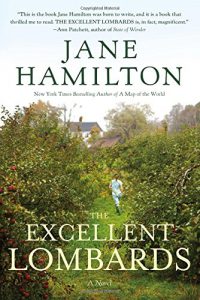 Every time I think about this book, I have to smile. That must be why I decided to review it for this edition of Friday Reads. It certainly wasn’t because everyone I know that read it loved it. Quite the contrary, most of my book group was indifferent or somewhat negative. But it’s a book that really got a lot of conversation going. And since I’m not the writer of the book, I prefer that to overwhelming acclaim.
Every time I think about this book, I have to smile. That must be why I decided to review it for this edition of Friday Reads. It certainly wasn’t because everyone I know that read it loved it. Quite the contrary, most of my book group was indifferent or somewhat negative. But it’s a book that really got a lot of conversation going. And since I’m not the writer of the book, I prefer that to overwhelming acclaim.
The story is told in the voice of Mary Frances Lombard, who at the beginning of the book is twelve years old and growing up on a family apple orchard. As the narrator, her voice rings loud and true for a precocious teen growing up in an increasingly endangered, changing rural area. Since she speaks in the voice of a teenage girl—not an adult looking back on her teenage self—she isn’t always the most pleasant character. But what teenager is? Mary Frances is full of ideas and plans. And for a young person, she is inordinately concerned about her future. Will she be able to stay on the farm? Will her brother be her business partner? Will a host of relatives and interlopers take over and push them out? And in the short term, will she win the Geography Bee and travel to Washington, DC to represent the state and bring glory to her family and her beloved teacher?
Since Mary Frances’ mom is the town librarian, librarian readers of this book will find that some of it is quite familiar. There’s plenty of realistic library customers, circulation desk kibitzing, and even a library book cart drill team drama in the story.
The land is a real character in this book—beautifully drawn and complicated, described as stunning and romantic yet brutally conflicted. In this book, the characters take center stage. I loved watching them grow and change over time. If you want a hard-driving storyline and plot, this might not be the book for you. If you can sit in a foreign film and just watch the visual beauty unfold on the screen, forgetting to read the subtitles, then you might like this book. One thing is certain, the writing is so good that you might just be stopped in the middle of the page to ponder what you just read (e.g., p. 46: “Time, we could see, was beginning to run as if it were leading somewhere, as it had not exactly done when we were very small, time occurring back then only in bursts.”). I highly recommend this book, especially if you want lots of discussion at your book club.
The Excellent Lombards by Jane Hamilton, Grand Central Publishing, 2016
Review by Mary Jo Ryan
#FridayReads
Friday Reads: Call if You Need Me
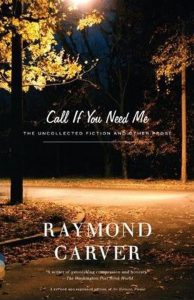 My original intention was to write about a big wave surfing book I recently picked up from my local library. This likely would have been more exciting than Raymond Carver. However, as I trekked successfully through 3/4’s of the big wave surf book (for me, this is an accomplishment), it soured. Maybe another day or another surfer. I’ve been looking for something on Kelly Slater, not only the most dominant surfer to date, but arguably the most dominant athlete ever. For those of you who like infographics, ahem, I mean data visualizations, check this one out – it’s among the best.
My original intention was to write about a big wave surfing book I recently picked up from my local library. This likely would have been more exciting than Raymond Carver. However, as I trekked successfully through 3/4’s of the big wave surf book (for me, this is an accomplishment), it soured. Maybe another day or another surfer. I’ve been looking for something on Kelly Slater, not only the most dominant surfer to date, but arguably the most dominant athlete ever. For those of you who like infographics, ahem, I mean data visualizations, check this one out – it’s among the best.
I picked up Call if You Need Me, a collection of short stories, essays, and book reviews by Raymond Carver, published posthumously, and finished the bulk of it on a rain suffused weekend, reading mostly while simultaneously standing and hopped up because of a neck injury. I skipped the book reviews within Call if you Need Me. Reading Carver is a lot like watching an episode of Mad Men. On the surface things seem quite normal and ordinary, but in reality that is far from the truth. Having read a few of Carver’s other works in the past, this is familiar territory, and the short stories in Call if You Need Me were interesting and easy to read. If anything, I’d say they were a little less miserable (and slightly less humorous) than Carver’s other works. The short stories are flooded with the imperfect, often despair ridden world we live in; a world many of us have experienced firsthand one way or another. There is a prevalence of alcoholism, divorce, and depression, but also humor, hope, and a sense of contentedness that we often lack. I enjoyed reading about the timeline of Carver’s life — writing short stories late at night out of necessity because he had two kids at a young age, being poor, his literary influences, childhood, and the eventual successful sales of his work. If you haven’t read any Carver, I recommend you give him a try. The fact that these are short stories (as most of Carver’s other works are) means that there is little investment on your part.
Friday Reads: The Grapes of Wrath, by John Steinbeck
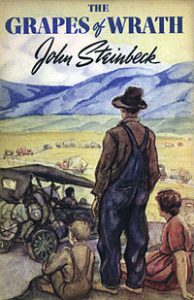 I recently re-read The Grapes of Wrath, and it felt so appropriate for today’s current events. My more experienced eyes were able to read the novel on more levels, as well. You know the story: Dust Bowl farm family sets off to California for the American Dream, but something has happened to the American Dream. There’s a wide cast of characters with realistic strengths and honest flaws, and we get the perspective of all of them over the course of the book—and they’re so frankly written, their desires so plainly stated, that we can easily identify with them—we’ve all been some part of some of these characters, at some points in our lives.
I recently re-read The Grapes of Wrath, and it felt so appropriate for today’s current events. My more experienced eyes were able to read the novel on more levels, as well. You know the story: Dust Bowl farm family sets off to California for the American Dream, but something has happened to the American Dream. There’s a wide cast of characters with realistic strengths and honest flaws, and we get the perspective of all of them over the course of the book—and they’re so frankly written, their desires so plainly stated, that we can easily identify with them—we’ve all been some part of some of these characters, at some points in our lives.
This time around, I was much more able to appreciate the unusual structure of the novel—the narrative chapters alternating with the more lyrical, prose-poem chapters. (Try reading any of the lyrical chapters aloud—you’ll be stunned by Steinbeck’s mastery of language when you feel yourself convey the words.) Steinbeck’s use of the form reinforces the timelessness of the tale—the narrative goes on in a familiar linear fashion, but it exists in a shifting, multi-dimensional framework outside of time, which is just as authentic as the narrative it contains, or the narrative that contains it.
There is no space between the author and what the author wants to convey to the reader—Steinbeck is not holding back, or affecting disaffection, in an effort to entice you. He does not play it cool for one second in this book. You will never doubt where his head is at. This earnestness could come off as preachy or strident in less capable hands, but I never had that experience with this book.
And Steinbeck’s earnestness, about the Joad family and what they are going through, about their moderate dreams, and about why they can’t achieve them, struck me as very relevant to today. The novel is set at the crossroads of economic, political and technologic times that resonate soundly today. Stuff you thought we’d have figured out almost a hundred years later, you know. The idea that farming and food production had become so successful, so advanced, and that people still didn’t have enough to eat—it was shocking then, and it’s shocking today. Today it’s not mechanized farming that we are trying to absorb and normalize, but other scientific advances—like GMOs, and the question of who owns the machines farmers use in their fields, and who gets to decide what to plant, to name just a few.
The novel also addresses the dynamic nature of populism, and how it can be used for the power of the people, and how it can be used to divide people and keep them down. The parallels between political leadership and religious leadership are easy to see in the character of the doubting preacher. And we read how religion can be used to bring comfort and encourage love and acceptance—and also how it can be used as a tool to control others, or even to our own disadvantage.
You can see why the book won a Pulitzer Prize. (The Pulitzer is celebrating its 100th birthday this year, by the way.) Also by the way: we have this book in our book club kits, so if you’re in Nebraska, your library can check this book out for your book club. You’ll have some good discussions, I promise. Definitely last, but definitely not least in your discussions—what is up with that ending? There are a lot of ways to interpret it. It would be interesting to hear what different people in the group think about it.
I’ll sign off with an audio clip from YouTube of Woody Guthrie singing “Tom Joad,” because why not.
(There are a few other musicians with songs about Tom Joad—the character seems to have really struck a chord with pop culture. It’s a fun search to try and find all the songs.)
Steinbeck, John. The Grapes of Wrath. New York: Penguin, 2002. Print.
Friday Reads: Textbook Amy Krouse Rosenthal, by Amy Krouse Rosenthal
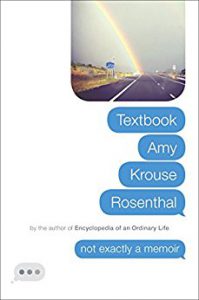 I first encountered Amy Krouse Rosenthal’s work when I was shopping for a baby book, back in those pre-kid days when I could still leisurely shop. The pale yellow book I chose was quirky and funny, with just enough sarcasm to balance out the preciousness that is the first year of your kid’s life. (Amy created several guided journals, and she was also a prolific children’s book author; one of her better known titles is Duck! Rabbit!)
I first encountered Amy Krouse Rosenthal’s work when I was shopping for a baby book, back in those pre-kid days when I could still leisurely shop. The pale yellow book I chose was quirky and funny, with just enough sarcasm to balance out the preciousness that is the first year of your kid’s life. (Amy created several guided journals, and she was also a prolific children’s book author; one of her better known titles is Duck! Rabbit!)
Her latest “grown-up” title, Textbook Amy Krouse Rosenthal, came out on August 9th, 2016. On September 6th, 2016, Amy was diagnosed with ovarian cancer. She passed away just last month on March 13th, 2017.
I’d had this book on my to-read list for a while, and I wish I’d read it sooner. It is a follow up to her 2005 memoir, Encyclopedia Of An Ordinary Life; she comments that it was only appropriate to follow an encyclopedia with a textbook. It is a short, fast read, with lots of white space. The book was meant to be “interactive”; Amy offers a cell phone number readers can text, so that at certain points in the book you can send her notes and photos and maybe even win a freshly-baked pie. Texts sent while Amy was alive were kept and added to the book’s website.
Amy writes of moments, of everyday occurrences. She makes the mundane experiences we all have seem both hilarious and absolutely heartbreaking. She talks of how fleeting life is and how, even if she were to live to 80, the number of times she could cut up an apple, or look at her children, wouldn’t be enough. There was no way she could have known, as she was writing those words, how small that number would become. There is no way for any of us to know, and I’m trying to remember that every day and live by her words: “Make the most of your time here.”
If you are already an “AKR” fan, tomorrow (April 29th) would have been her birthday. There is a Facebook group, #MoreForAKR, that you can check out if you’d like to pay tribute to Amy’s memory this weekend with acts of kindness.
Friday Reads: Garvey’s Choice by Nikki Grimes
Garvey is 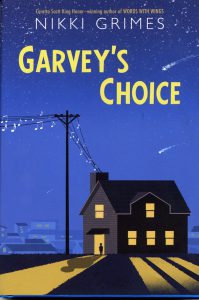 not interested in sports at all. He is interested in reading, science, and jokes, which his father does not value. His dad keeps trying to pique his interest in becoming an athlete and is not able to drop the topic. Garvey knows he is not an athlete but is not certain who he is. He faces bullies at school due to his weight and awkwardness. Finally Garvey’s best and only friend since first grade guides him to Chorus at school, where he finds his place and a second friend. His wonderful voice is valued and his confidence grows. Now his dad has something in common with him at long last, since many years ago he sang in a band.
not interested in sports at all. He is interested in reading, science, and jokes, which his father does not value. His dad keeps trying to pique his interest in becoming an athlete and is not able to drop the topic. Garvey knows he is not an athlete but is not certain who he is. He faces bullies at school due to his weight and awkwardness. Finally Garvey’s best and only friend since first grade guides him to Chorus at school, where he finds his place and a second friend. His wonderful voice is valued and his confidence grows. Now his dad has something in common with him at long last, since many years ago he sang in a band.
This short, small book offers a heartfelt story about finding one’s place and uses a poetry form that may be new to many. It is told in tanka poetry which involves five lines with a particular number of syllables for each, and is explained at the back of the book. Spend a little time with Garvey and friends Joe and Manny to relive what it is like to be an adolescent again. You will leave content.
Grimes, Nikki (2016). Garvey’s Choice. Honesdale, PA: Wordsong.
Friday Reads: Just a Geek
 For Christmas a few years ago, I received two biographies by Wil Wheaton. Yes, THAT Wil Wheaton. Wesley Crusher himself! I also discovered his blog. And then his Twitter…and then Facebook. Makes me look like a stalker, doesn’t it? But no, I’m not. He puts himself right out there, just like the rest of us!
For Christmas a few years ago, I received two biographies by Wil Wheaton. Yes, THAT Wil Wheaton. Wesley Crusher himself! I also discovered his blog. And then his Twitter…and then Facebook. Makes me look like a stalker, doesn’t it? But no, I’m not. He puts himself right out there, just like the rest of us!
So, I started with Just A Geek: Unflinchingly honest tales of the search for life, love, and fulfillment beyond the Starship Enterprise. Wow, that’s a freakishly long title. We’ll call it Just A Geek from now on. It’s a collection of some of the posts from his blog, but with updated info and commentary by him.
Now, you may only know Wil Wheaton as an actor. But I’ve discovered that Wil is also a great storyteller. I started just reading his blog, jumping around seeing what he has been saying over the years. He is funny and smart and he can definitely make you all teary-eyed when he wants to.
My favorite part of Just A Geek is when Wil looks back on his old blog posts with a new perspective. Time changes things. He looks back and see events very differently. Sometimes he had to wait until years later to understand what was really happening. And other times, you learn that the real story wasn’t really told in the first place. Looking back on his life helps him come to terms with what really happened and share the truth with his readers.
Yes, there are some Star Trek stories in there, which made the Star Trek fan in me squee. And yes, he is quite the geek, another plus from the geek in me.
If you want to continue reading more stories based on his blog, he has continued them in two more books – Dancing Barefoot and The Happiest Days of Our Lives. If non-fiction or autobiography isn’t your thing, he also writes fiction. I recommend starting with The Day After and Other Stories, a collection of his short stores. I can’t wait to see what he comes up with next!

